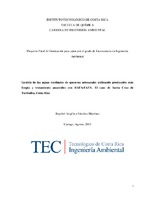Mostrar el registro sencillo del ítem
Gestión de las aguas residuales de queseras artesanales utilizando producción más limpia y tratamiento anaerobio con RAFA-FAFA
| dc.contributor.advisor | Zambrano-Piamba, Diana | es |
| dc.contributor.author | Sánchez-Martínez, Reychel Angélica | |
| dc.date.accessioned | 2015-10-02T23:05:25Z | |
| dc.date.available | 2015-10-02T23:05:25Z | |
| dc.date.issued | 2015 | |
| dc.identifier.uri | https://hdl.handle.net/2238/6284 | |
| dc.description | Proyecto de Graduación (Licenciatura en Ingeniería Ambiental) Instituto Tecnológico de Costa Rica, Escuela de Química, 2015. | es |
| dc.description.abstract | The cheese industry in the country is an activity in constant growth, however there are no regulations for the related activities, facilities, waste management, water management, among others. The lack of implementation tools in clean production and poor liquid waste disposal, generate environmental problems. The whey is the main component of pollution associated with these waters, generating inhibition in the treatment of waste water by high levels of COD, fats, solids and early tendency to acidification. The present investigation provides a diagnostic in environmental issues to some non-industrial cheesemakers, and proposes management strategies by implementing clean production in their processes and an assessment of hybrid RAFA-FAFA anaerobic treatment for decontaminating their wastewaters. Environmental audits were conducted in five dairies in the area of Santa Cruz de Turrialba, where their processes, activities, facilities, and wastewater management were characterized as well as the conduction of physical and chemical analysis for the wastewater in each dairy. Using the tool EcoInspector 2.1, areas with potential for improvement were identified. A dairy farm was chosen for feeding two pilot hybrid anaerobic reactors. The reactors treatability were evaluated without adding alkalinity, with a COD: 2 (g / L), HTR: 3.5 d, VOC: 0.5714 (kg COD / m3 d *) and then with a dose of 2g / L NaHCO3 / L for the substrate, approximately 3 g / L COD, HTR: 2.3 d, VOC 1.2857 (kg COD / d * m3). It was found that while the dairies produce the same type of cheese, there are differences between them and the areas where they present greater opportunities for improvement in the standardizing of their processes, water recycling, wastewater treatment management, curd production for cheese and the reuse of whey. The wastewater generated is difficult to treat and will have variable characteristics; it is not possible to implement hybrid reactors without adding alkalizing, because the rapid acidification; whereas with values between (3-6) g COD/L, the addition of 30 g NaHCO3/L of alkalizer for the conditioning of inoculum, 2 g NaHCO3/L and 1 mL/L of nutrient solution for the substrate, it is feasible to use hybrid anaerobic systems, reaching COD removal efficiencies between (65-90)%, but should expand the study of this type of treatment. | es |
| dc.description.sponsorship | Instituto Tecnológico de Costa Rica. Escuela de Química. | es |
| dc.language.iso | es | es |
| dc.publisher | Instituto Tecnológico de Costa Rica | es |
| dc.rights | acceso abierto | es |
| dc.subject | Gestión ambiental | es |
| dc.subject | Quesos | es |
| dc.subject | Manipulación de Alimentos | es |
| dc.subject | Tratamiento de aguas residuales | es |
| dc.subject | Protección del medio ambiente | es |
| dc.title | Gestión de las aguas residuales de queseras artesanales utilizando producción más limpia y tratamiento anaerobio con RAFA-FAFA | es |
| dc.title.alternative | El caso de Santa Cruz de Turrialba, Costa Rica | es |
| dc.type | proyecto fin de carrera | es |


